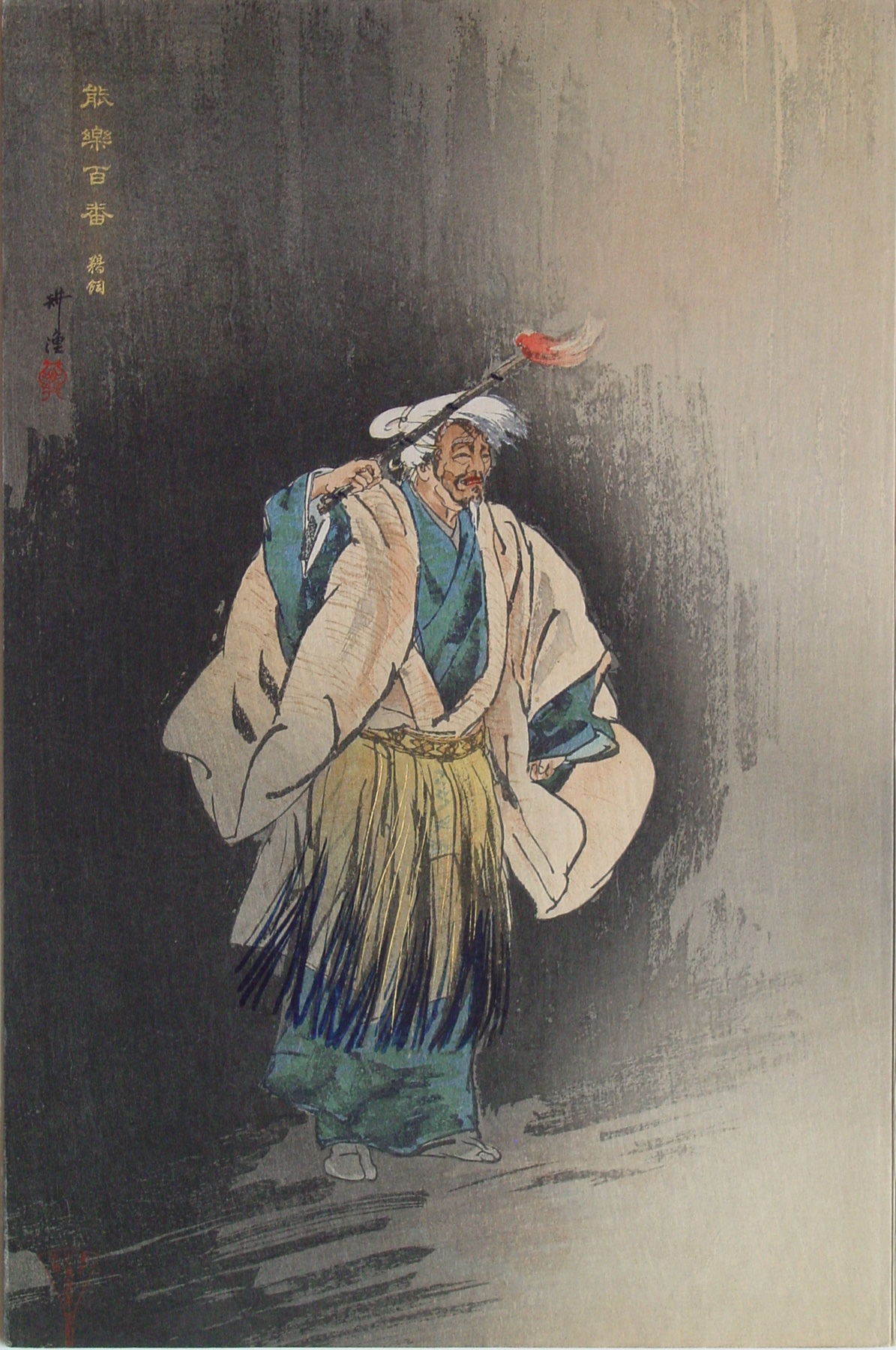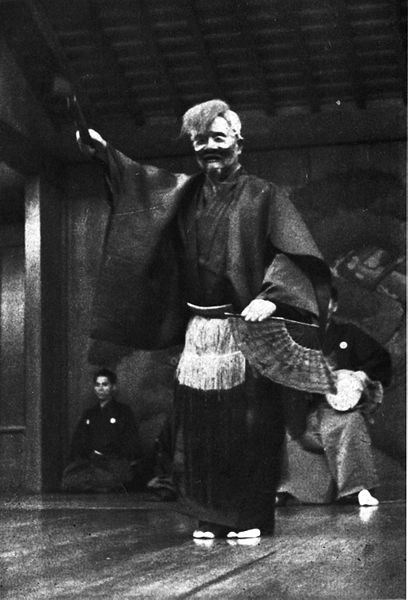About This Print
One of 120 prints issued as part of the series Nōgaku hyakuban (One Hundred Prints of Noh), it depicts a scene from the play Ukai attributed to the playwright Enami no Sayemon (c. 1400) in which the ghost of an old cormorant fisherman appears with a torch demonstrating the technique of cormorant fishing before the priest Nichiren. This print was originally released by the publisher Matsuki Heikichi in the twenty-thirdinstallment of prints in this series. This series' prints were offered in monthly installments consisting of three prints packaged in an envelope with additional descriptive information.1For other depictions of this play see Ukai from the series Nōgakuzue, by Kōgyo and Ukai (The Cormorant Fisher), No. 10 from the series Fifty Noh Figures in Color by his student Matsuno Sōfū (1899-1963).
The Play - Ukai (The Cormorant Fisher) by Sayemon
Source: A Spectator's Handbook of Noh, Murakami Upton and Yoshiko Upton, Wanya Shoten, Tokyo, 1968, p. 89.The priest Nichiren determines to pass the night in a haunted temple. The ghost of an old cormorant fisherman who once sheltered him appears, explaining that for violating the strict prohibition against taking life in the nearby river by fishing there nightly with his cormorants he was punished by being drowned in the river. When the priest promises prayers for his soul he demonstrates how the fishing is done; then disappears. When Nichiren writes words from the Lotus Sutra on some stones and throws them into the river, Emma, the King of Hell, announces the fisherman's suffering is remitted and he will be sent to Paradise because of his kindness to the priest.
FISHER.
When the fisher's torch is quenched
What lamp shall guide him on the dark road that lies before?
Truly, if the World had tasked me hardly
I might be minded to leave it, but this bird-fishing,
Cruel though it be in the wanton taking of life away,
Is a pleasant trade to ply
Afloat on summer streams.
I have heard it told that Yūshi and Hakuyō vowed their love-vows
by the moon, and were changed to wedded stars of heaven. And
even today the high ones of the earth are grieved by moonless nights.
Only I grow weary of her shining and welcome nights of darkness.
But when the torches on the boats burn low,
Then, in the dreadful darkness comes repentance
Of the crime that is my trade,
My sinful sustenance; and life thus lived
Is loathsome then.
Yet I would live, and soon
Bent on my oar I push between the waves
To ply my hateful trade.
I will go up to the chapel as I am wont to do, and give my cormorants
rest. (Seeing the PRIESTS.) What, have travelers entered here?2
67, Society for Japanese Arts, p. 28.
2 The No Plays of Japan, Arthur Waley, BiblioLife, 2009 (originally 1921) p. 128.
Print Details
| IHL Catalog | #162 |
| Title | Ukai 鵜飼 (The Cormorant Fisher) |
| Series | Nōgaku hyakuban 能楽百番 (One Hundred Prints of Noh or One Hundred Noh Plays) |
| Artist | Tsukioka Kōgyo (1869-1927) |
| Signature | Kōgyo |
| Seal |  unread seal not shown in Appendix 1 of in The Beauty of Silence: Nō and Nature Prints by Tsukioka Kōgyo (1869-1927), Robert Schaap & J. Thomas Rimer, Hotei Publishing, 2010. unread seal not shown in Appendix 1 of in The Beauty of Silence: Nō and Nature Prints by Tsukioka Kōgyo (1869-1927), Robert Schaap & J. Thomas Rimer, Hotei Publishing, 2010. |
| Date | February 1923 |
| Edition | unknown |
| Publisher | Matsuki Heikichi (Daikokuya) |
| Carver | |
| Impression | excellent |
| Colors | excellent |
| Condition | good - backed and trimmed |
| Genre | nishiki-e; nōgaku zue 能樂圖繪 [Noh play picture] or 能絵 [Noh-e] |
| Miscellaneous | |
| Format | oban tate-e |
| H x W Paper | 14 5/8 x 9 5/8 in. (37.1 x 24.4 cm) |
| Collections This Print | Scripps College 2007.1.99; Los Angeles County Museum of Art AC1997.254.27; Art Institute of Chicago 1943.834.49 |
| Reference Literature | The Beauty of Silence: Nō and Nature Prints by Tsukioka Kōgyo (1869-1927), Robert Schaap & J. Thomas Rimer, Hotei Publishing, 2010, pl. 68, p. 120. |



